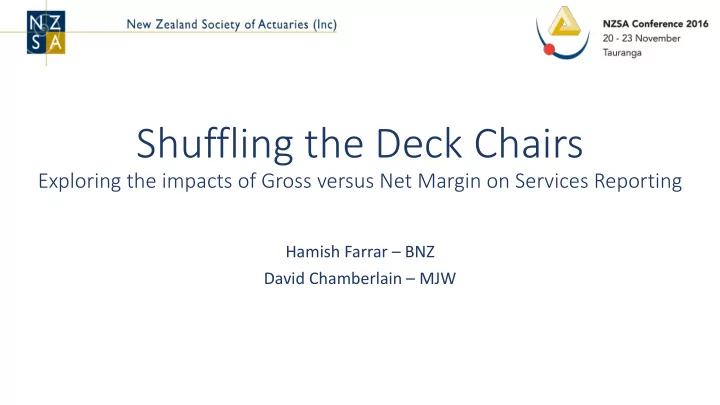

Shuffling the Deck Chairs Exploring the impacts of Gross versus Net Margin on Services Reporting Hamish Farrar – BNZ David Chamberlain – MJW
Disclaimers The opinions expressed in this presentation are those of the authors and do not necessarily represent the views of our respective employers. We have a life insurance focus and don’t cover participating business We have removed names where possible
Why did we choose this subject? • An issue that keeps on coming up but the actual technical detail isn’t necessarily well understood • To highlight some of the issues that need to be thought about when producing policy liability numbers for financial statements • Because the authors enjoy playing around with things and trying to make them break
What this paper is about • A short history of the standards driving policy liability reporting • An exploration of issues in Margin on Services Reporting • Particular focus on gross verses net valuation • A starting point for people to think more deeply about some of the issues • This paper is not about instructing anybody on what they should do
Background • Margin on Services (MoS) Reporting • Introduced in Australia in 1995 • In NZ FRS 34 applied from balance dates on or after 31 December 1999 • An attempt to make financial statements more comparable • Relates profits to services and releases profits over the lifetime of a policy (smooths?) and removes new business strain (at least in the profit sense) • Priority was to get a realistic profit (P&L more important than B/S => NZSA had to introduce a “solvency standard” GN5 to cater for the adulterated B/S) • Interesting to note the primacy of the P&L may no longer be de rigueur – is the change in statutory solvency (distributable profit) all that matters now? • As the environment has evolved a number of issues have emerged with MoS
Background • Base model • Male non-smoker aged 40 through to age 65 • Death only with $750,000 SA • 80% NZ04 • 4% after tax discount rate with 28% tax rate • $650 initial expenses, $150 renewal expenses and 2.5% inflation • 200% initial commission and 7.5% renewal is upfront model (20% level) • YRT premium rates from internet • Any capital (assets) assumed is just solvency capital of 1‰ catastrophe charge
Background
Background • IFRS 4 • Introduced in 2004 • Not really an international approach as it let everybody keep doing what they had been doing • Improved disclosure but maybe not in the areas that mattered • Was only intended as a temporary measure until IFRS 4 Phase 2 • NZ IAS 12 • Objective is to prescribe the accounting treatment for income taxes • Introduced in 2004 with many later amendments
Background • ED113 • Was to clarify the operation of NZ IAS 12 • Never introduced • Tax changes • Brought into force 1 July 2010 • Included a transitional period to avoid a shock to the industry • But MoS on a net basis didn’t play well with the transitional period
Background
What we found • Issues with MoS • Distorts understanding of issues due to smoothing • Starting Amounts were never likely to be accurate • Not symmetric • Not a measure of profitability • Profit emergence is impacted by choice of profit carrier • Modelling of cash flows isn’t perfect • There are many more issues
What we found • Gross of tax on cash flows, net discount rate
What we found • Things to consider with implementation (DAC run-off) • Level premium policy
What we found
What we found • NZ IAS 12 doesn’t allow discounted deferred tax • You can’t infer Deferred Acquisition Costs from the Policy liability • Need to track DAC explicitly and run- off in a fashion that isn’t discounted • One possibility is to use the non-discounted profit carrier • However very few companies have DAC calculated from inception • If everything else is equal then this DTL would be the same number under both gross and net valuations
What we found • If the DTL is the same under all methodologies then what differences arise
What we found • If the DTL is the same under all methodologies then what differences arise
What we found • Separating out the DTL increases solvency requirements under a strict interpretation of the Solvency Standard • This is because the IRCC will increase due to the increase in Other Liabilities but the total accounting liabilities haven’t changed • Should a format change in the financial statements result in a changed solvency requirement? • Could argue that this part of the DTL is really part of the policy liability • Harder to argue in the case of a gross valuation and calls into question the accounting treatment anyway
Conclusions • Do accountants understand enough about what actuaries do? • Do actuaries understand enough about what accounting standards are trying to do? • Accounting standards are conflicted • Need to explore these issues more deeply • The impact of how you treat deferred tax in financial statements isn’t really going to materially impact the comprehension of them as there are much bigger problems • Is all we care about anyway just the “distributable profit” ???
Conclusions
Recommend
More recommend